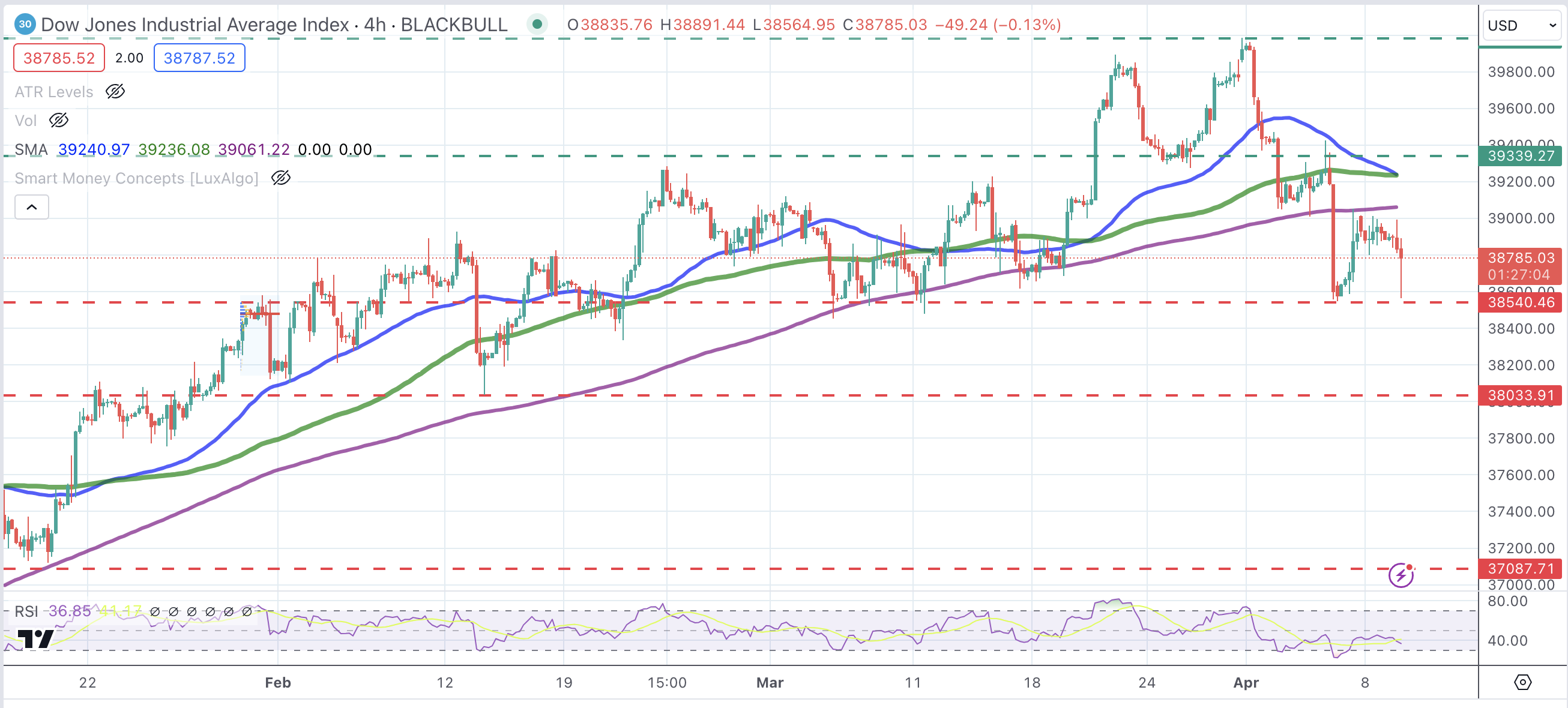- Analytics
- News and Tools
- Market News
- Dow Jones Industrial Average dips into losses as market sentiment falters
Dow Jones Industrial Average dips into losses as market sentiment falters
- Wall Street turns lower with investors turning cautious ahead of US CPI release.
- US inflation is expected to show mixed readings with levels well above the Fed’s 2% core target rate.
- The Dow Jones Index has found support at 38,540, although broader bias remains negative.
The Dow Jones Industrial Average (DJIA) has dropped into negative territory during Tuesday’s US morning session. The moderate risk appetite seen during the European trading session has waned in the US, with investors taking a cautious stance ahead of Tuesday’s US CPI release.
US Consumer Inflation is expected to have accelerated to 3.4% in March from the 3.2% annual rate in February. The core CPI, which scraps the impact of seasonal food and energy prices, is estimated to ease to 3.7% from a 3.8% annual reading for February. In any case, showing levels well above the Federal Reserve’s (Fed) 2% core inflation rate for price stability.
The cautious market mood has sent all the main Wall Street indices lower on Tuesday, although they are pulling back from session lows at the moment of writing. The Dow Jones drops 0.4% to 38,738, the S&P 500 drops 0.3% to 5,186 and the NASDAQ Index eases 0.15% lower to 16,225.
Dow Jones news
Among sectors, the Financials are getting the biggest blow with a 0.71% loss, followed by the Industrials, 0.5% lower, and Technologies, dropping 0.38%. Real Estate is the only sector showing some advance, up 0.7%, while Utilities and Consumer Staples are flat.
Travelers Companies (TRV) is the worst-performing stock in the Dow Jones, losing 2.3% to $225.28, followed by American Express (AXP) which is down 1.8% to $219.83. The biggest winners are Cisco Systems (CSCO), up 2.79%, to $49.59, and 3M (MMM), advancing 1.23% to $93.06.
Dow Jones technical outlook
The technical picture shows the Dow Jones index picking up after having tested the support area at 38,540. The broader trend, however, remains bearish with the pair correcting lower from March highs near 40,000.
A further decline below 38,540 would expose February’s low at 38,035. On the upside, the pair should breach the 39,340 resistance area to break the negative price structure and open the path toward the all-time high at 39,985.
Dow Jones Index 4-Hour Chart

Inflation FAQs
Inflation measures the rise in the price of a representative basket of goods and services. Headline inflation is usually expressed as a percentage change on a month-on-month (MoM) and year-on-year (YoY) basis. Core inflation excludes more volatile elements such as food and fuel which can fluctuate because of geopolitical and seasonal factors. Core inflation is the figure economists focus on and is the level targeted by central banks, which are mandated to keep inflation at a manageable level, usually around 2%.
The Consumer Price Index (CPI) measures the change in prices of a basket of goods and services over a period of time. It is usually expressed as a percentage change on a month-on-month (MoM) and year-on-year (YoY) basis. Core CPI is the figure targeted by central banks as it excludes volatile food and fuel inputs. When Core CPI rises above 2% it usually results in higher interest rates and vice versa when it falls below 2%. Since higher interest rates are positive for a currency, higher inflation usually results in a stronger currency. The opposite is true when inflation falls.
Although it may seem counter-intuitive, high inflation in a country pushes up the value of its currency and vice versa for lower inflation. This is because the central bank will normally raise interest rates to combat the higher inflation, which attract more global capital inflows from investors looking for a lucrative place to park their money.
Formerly, Gold was the asset investors turned to in times of high inflation because it preserved its value, and whilst investors will often still buy Gold for its safe-haven properties in times of extreme market turmoil, this is not the case most of the time. This is because when inflation is high, central banks will put up interest rates to combat it. Higher interest rates are negative for Gold because they increase the opportunity-cost of holding Gold vis-a-vis an interest-bearing asset or placing the money in a cash deposit account. On the flipside, lower inflation tends to be positive for Gold as it brings interest rates down, making the bright metal a more viable investment alternative.
© 2000-2024. All rights reserved.
This site is managed by Teletrade D.J. LLC 2351 LLC 2022 (Euro House, Richmond Hill Road, Kingstown, VC0100, St. Vincent and the Grenadines).
The information on this website is for informational purposes only and does not constitute any investment advice.
The company does not serve or provide services to customers who are residents of the US, Canada, Iran, The Democratic People's Republic of Korea, Yemen and FATF blacklisted countries.
Making transactions on financial markets with marginal financial instruments opens up wide possibilities and allows investors who are willing to take risks to earn high profits, carrying a potentially high risk of losses at the same time. Therefore you should responsibly approach the issue of choosing the appropriate investment strategy, taking the available resources into account, before starting trading.
Use of the information: full or partial use of materials from this website must always be referenced to TeleTrade as the source of information. Use of the materials on the Internet must be accompanied by a hyperlink to teletrade.org. Automatic import of materials and information from this website is prohibited.
Please contact our PR department if you have any questions or need assistance at pr@teletrade.global.















